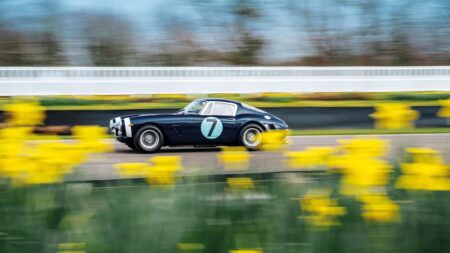“For 40 years the chassis was in the hands of a private collector who didn’t want to sell,” Velebný says, “but when he died two years ago we purchased it from his beneficiaries and began reconstruction. It should be ready in 2019. This car was built 60 years ago in the development department and they are helping us recreate the body using old 2D drawings from our archive, but applying modern technology. They have reverse-engineered it to use 3D and we already have a 1:4-scale model, which is the correct shape. We used archive pictures to help us do things properly and hope the end result will reflect reality.”
For all its aesthetic charm, anybody weaned on modern cars might wonder how ever it was possible to race something like this for a long stint. The cockpit is cramped, there is no fore-and-aft seat adjustment and even on a simple course – a long straight with hairpin turns at either end – my right leg was beginning to ache after a couple of minutes, largely because it was bent almost double to reach the throttle. The gearchange – first is across and down, somewhere in the middle of your thigh, with second to fifth in a conventional H-pattern – seemed vague initially, but was actually very easy to use, the drum brakes provided lots of feel but little retardation, the thin-rimmed wooden wheel felt as though it might snap if used aggressively and there were no belts nor any other kind of safety feature, but I could happily have bumbled around all day in it – a brittle echo of the way things were.
The 130 RS served as a reminder of a time when all road cars had drinking straws – rather than tree trunks – as A-pillars. Inside it looked pretty standard, give or take the absence of trim. It has no starter button, just an everyday key, and felt wonderfully tractable through its four-speed ’box – the kind of car you could use for the school run, as well as scooping touring car titles. It was red-lined at 6000rpm and got there pretty quickly, despite having only 1.3 litres.

1100 sports car is a particularly elegant Skoda racing example
Matt Howell
“The rally version was particularly effective on fast, flowing asphalt,” Haugland says, “simply because it handled so well. With a small engine we obviously struggled against the bigger cars on tight, twisty stages, because we didn’t have the punch out of slower corners, but in terms of top-end cornering speeds it was a match for almost anything.
“People used to think I must be an amazing driver because I was winning rallies in what they assumed was a shit car, but the Škodas were absolutely fantastic. They might not have been as powerful as other things, but they were incredibly well balanced.”
That also applies to the modern R5, in which Kopecký and I were able to conduct a civilised conversation while he calmly performed one-handed donuts to illustrate the car’s manoeuvrability – it looked far more dramatic from outside than it felt from within.









